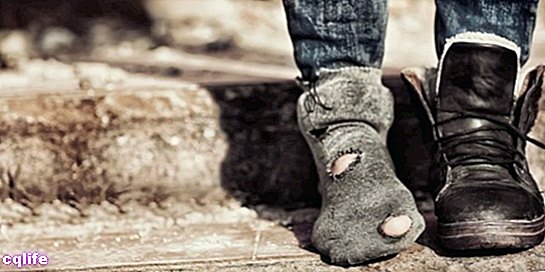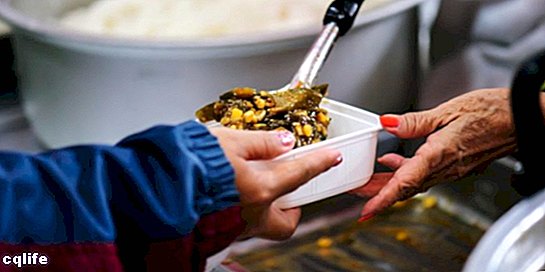- What is poverty?
- Causes of poverty
- Types of poverty
- Consequences of poverty
- Poverty in the world
- Poverty in Mexico
We explain what poverty is, its causes, consequences and the types of poverty that exist. Also, figures in Mexico and the world.

What is poverty?
Poverty is a socioeconomic condition in which resources are scarce, or the necessary tools to acquire them on a regular basis. Those who suffer from it cannot satisfy their basic needs, physical and mental, that guarantee an adequate quality of life: feeding, housing, healthcare, education formal.
In some cases it also implies the lack of access to basic services such as electricity, drinking water, phone line, etc. In other words, poverty is much more than a mere lack of capital.
There are multiple social, economic and even psychological factors involved in poverty, and also different ways of measuring and understanding it. However, in general terms, the line of the beginning of poverty is drawn when one suffers from the lack of fundamental means for subsistence.
In many cases it is a consequence of chronic unemployment, a very low level of income. In addition, the conditions of significant marginalization and social exclusion make social advancement and integration more difficult in terms of equality on the community. In other words, the poorer a person is personThe harder it is to find opportunities to change your situation.
Poverty is one of the main problems of the industrialized world, since it is due to other ills and sufferings in the nations, in a world that exhibits profound inequalities. Although there do not seem to be 100% effective methods to combat it, many institutions of all kinds are dedicated to their own plans to reduce it.
In fact, according to the measurements of the UNIt is estimated that from the year 2000 the growth of poverty at a global level was halted, which could be the beginning of the slow and long process of beginning to reverse it.
Causes of poverty
Poverty has always existed, since the societies early, since it is a consequence of the unequal distribution of wealth, something that seems to be nested within human societies forever. In fact, the word itself comes from Latin pauper, which means "infertile", probably associated with those who cultivated less generous lands than those of others.
However, the existence of poverty is not due to simple causes, but is the consequence of a series of historical, social and cultural conditions that, on the other hand, afflict different societies in different ways.
For example, him colonialism of the European powers, who plundered and subdued the other continents, can be seen as a factor causing their former colonies to enter the modern world in unequal conditions, lack of resources, populations decimated by the war of independence.
Furthermore, for the most part their economic systems were dependent, which quickly translated into considerable poverty margins. In fact, many of the former colonies are today part of the so-called Third World.
Furthermore, poverty often leads to significant educational deficiencies, including sexual and reproductive education, so that poor populations are more prone to early pregnancy and unplanned family. These conditions reduce their chances of overcoming and restart the cycle of marginalization and poverty, throughout generations.
Another cause of poverty at the global level is wars and conflicts They leave those who suffer them helpless: refugees, migrants or survivors, almost always reduced to conditions of poverty and forced to start from scratch, either in their devastated country or in a foreign country where they have nothing and no one knows them.
Types of poverty
The main distinction when talking about poverty is between critical poverty and extreme poverty, depending on the amount of vital deprivation that the person suffers:
- Critical poverty. It is suffered by citizens who are unable to comply with the basic basket of consumption, composed not only of food and supplies, but of basic basic services. Generally, individuals in this situation invest absolutely all their capital in the feeding exclusively.
- Extreme poverty. Considered as an inferior step with respect to criticism, the inhabitants in this condition not only cannot access the basic basket of foodbut they cannot even consume a basic amount of calories daily to guarantee a level of life worthy. At this level are the homeless, for example.
On the other hand, the measurement According to the socioeconomic context, it distinguishes between two other categories of poverty levels: absolute poverty and relative poverty.
- Relative poverty. It is a concept that depends on the immediate socioeconomic environment of a town, a region, a country or a continent, as it is determined by the relationship with other individuals in society. Furthermore, the economic and social terms of one place may be very different from those of another, and they are not always directly comparable.
- Absolute poverty. On the contrary, absolute poverty is a general measurement of the population, applying more or less uniform criteria for this, such as the minimum consumption basket. It is a comparative value in the same terms, in order to establish a net poverty amount.
Consequences of poverty

Poverty has significant consequences in the lives of people and in the group of nations, such as:
- Malnutrition. Poverty prevents the child population from accessing the caloric levels necessary to grow strong and healthy, thus raising the rates of mortality infantile and giving way to generations weaker than their predecessors.
- Pandemics In countries where extreme poverty is abundant, there are large sectors of the population that are marginalized and with little or no access to public health. In these cases, the appearance of mass contagion diseases or the reappearance of diseases that had been considered eradicated is common.
- Low human development. In general, societies with high margins of poverty show slower consumer markets, less investment in culture and, in general terms, less development as a society.
- Crime and drugs. Although poverty does not have any direct and necessary link with crime and the proliferation of drugs, nor are these two elements exclusive to it, it is true that being in desperate economic and social conditions, the poor are the most likely to accept business turbid in exchange for an improvement in their economic income. In addition, in many cases drug use is part of the strategies escape from poverty, given that in many cases the rational options to stop being poor appear to be few or none at all. However, this is a consequence only in some cases.
- Social resentment. Poverty leads to exclusion. In some cases, exclusion leads to resentment, and resentment can develop into urban violence, and other mass phenomena whose results can be unpredictable. However, the violence It is not an exclusive characteristic of people who suffer from poverty and, on the other hand, most of them are not violent.
Poverty in the world
The measurement of poverty carried out in 2012 by the organizations of the World Bank, yielded the following figures:
- Poverty is around 22.43% in developing countries. developing, which represents a relative improvement compared to the 52.16% registered in 1981.
- 2 billion people in the world still lack access to medicines and suffer from anemia.
- More than 1,000 million people in the world can be considered in extreme poverty, they lack stable housing and 70% of them are women.
- More than 1.8 billion people do not have access to safe water.
- Around 100,000 people die of hunger every day.
Many international organizations fight poverty through large-scale initiatives, ranging from educational plans (UNICEF), medical and food aid (Doctors without Borders, UN), or simply projects of economic protection and international aid (IMF, World Bank).
Even so, the inequality between the nations of the developed world and those of the so-called Third World is so significant that there is no easy solution to the drama of poverty.
Poverty in Mexico
The Mexican population has less than 50% of citizens living below the international poverty line, according to the terms of the World Bank. But it is estimated that, in terms of national measurement, the percentage of poverty in Mexico is very significant.
Thus, 76.9% of the total Mexican population lives in moderate poverty, 28.2% in relative poverty, 13.4% in absolute poverty, and 1.8% in extreme or critical poverty.
These non-cumulative percentages come from the Report on the Human development of the United Nations of 2015. All of the above translates into 87.7 million people living in moderate poverty; 33.6 million living in relative poverty; 15.2 million living in absolute poverty; and 2.2 million living in extreme poverty.
